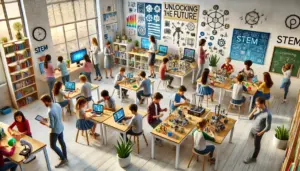STEAM Education: Driving US Economic Growth
Innovation stands as the bedrock of American prosperity, with a substantial portion of economic expansion attributed to enhanced productivity, a direct result of innovation. To sustain this trajectory of innovation and productivity, a heightened emphasis on science, technology, engineering, arts, and math (STEAM) skills is imperative. These skills are in high demand by employers, with STEAM sectors witnessing employment growth from 2008 to 2012, whereas non-STEM sectors were still recovering from the recession as of 20121. The demand for STEAM skills is projected to intensify, with employment forecasts indicating a more rapid expansion in STEAM roles than non-STEAM roles from 2012 to 20221.
Key Takeaways
- STEAM education prepares students for high-demand careers in fields such as information technology, engineering, and healthcare2.
- Students who participate in STEAM programs excel academically, notably in mathematics and science2.
- STEAM education encourages students to address global issues such as climate change, healthcare, and sustainable development2.
- Integrating arts into STEM aims to provide a balanced education that fosters creative thinking and analytical skills3.
- STEM education contributes to increased productivity in various industries by equipping individuals with problem-solving, critical thinking, and cutting-edge technology skills1.
The Importance of STEAM Skills in the Innovation Economy
In the current, fast-paced, and ever-changing global environment, the integration of STEAM (science, technology, engineering, arts, and mathematics) skills has emerged as paramount for innovation and economic advancement. The STEAM methodology necessitates students to engage in critical thinking, creative problem-solving, and collaborative endeavors. These competencies are indispensable for excelling in the contemporary workforce.
Definition of STEAM and its Role in Driving Innovation
The STEAM framework augments the conventional STEM (science, technology, engineering, and mathematics) curriculum by incorporating the arts. This inclusion stimulates creativity and innovation. Such a comprehensive approach equips individuals with the skills essential for success in an era where innovation underpins economic development. STEAM education fosters critical thinking, empowering students to address intricate challenges and devise innovative solutions. These solutions propel progress across diverse industries.
Increasing Demand for STEAM-Capable Workforce
The rapid evolution of technology is reshaping the employment landscape, elevating the demand for a STEAM-capable workforce. The U.S. Bureau of Labor Statistics indicates that STEM occupations have expanded by 79% since 1990, outpacing the overall U.S. job growth4. Moreover, Gartner forecasts that 80% of project management tasks will be automated by AI by 20304. Hence, STEAM education is indispensable in equipping students for the high-demand jobs of the future. It ensures a robust talent pipeline, crucial for sustaining innovation and maintaining the nation’s economic competitiveness.
Parents are increasingly steering their children towards STEM subjects; 52% anticipate an uptick in STEM job opportunities within the next decade4. Concurrently, 57% of senior executives prioritize soft skills over technical skills4. This paradigm shift highlights the significance of STEAM-driven education. It cultivates critical thinking, creativity, and collaboration – the pivotal 21st-century skills sought after in the innovation economy.
“STEAM education establishes the foundation for innovation and creativity by melding these disciplines into the educational experience. This integration prompts students to engage in critical thinking and complex problem-solving. These skills are fundamental to innovation, driving advancements across industries and fueling economic growth.”
Wide Range of Opportunities for STEM-Capable Workers
The escalating demand for STEM (Science, Technology, Engineering, and Mathematics) expertise heralds a plethora of opportunities for the adeptly qualified5. STEM education’s influence on employment is profound, manifesting in enhanced job prospects, diminished social expenditures, and a broader spectrum of career avenues for its alumni5. Notably, STEM graduates exhibit lower unemployment rates, underscoring the sector’s robust job security and the multitude of career paths available to them5.
Higher Wages and Faster Wage Growth in STEM Occupations
The financial incentives for a STEM career are substantial6. In 2019, STEM professionals commanded a median income of $55,000, eclipsing the $33,000 median for non-STEM counterparts6. Concurrently, the unemployment rate within the STEM sector was a mere 2%, a stark contrast to the 4% rate within the non-STEM domain6. This disparity underscores the heightened demand and superior employment opportunities for STEM-skilled individuals5. Moreover, STEM education’s impact is multifaceted, effectively curbing youth unemployment and ensuring employment stability by equipping individuals with requisite competencies5.
The advantages of STEM education transcend mere financial gains and improved employment prospects7. Research indicates that STEM education fosters entrepreneurial acumen and yields beneficial outcomes for both employers and employees7. This education is rigorously integrated from the preschool to tertiary levels, with tertiary institutions investing significantly in STEM-related endeavors, highlighting the critical nature of these skills57.
In conclusion, the extensive array of opportunities and the superior remuneration and wage growth dynamics within STEM fields render a STEM-related career an attractive choice for individuals aiming to enhance their financial and professional prospects6.
How STEAM Education Drives Economic Growth
STEAM education is pivotal for economic flourishing, cultivating a workforce adept at navigating intricate challenges8. Through comprehensive academic programs and practical learning, students hone their analytical prowess, problem-solving skills, and technological acumen, vital for excelling in today’s complex economy8. This education fosters a robust STEAM talent pool, enabling nations to innovate and adapt, thereby propelling sustained economic expansion and augmenting competitiveness8.
The STEM technopolis paradigm seeks to embed STEAM education within local technological frameworks, thereby enhancing regional advancement8. It identifies industry clusters as pivotal for technopolis initiatives, engaging students, educators, employers, and development entities8. Dr. Zintgraff champions the inclusion of primary and secondary education in STEM policies, establishing a self-reinforcing cycle of growth8. This cycle underscores the linkage between technological progress and economic development, highlighting the necessity of engaging students in STEAM subjects to enter these sectors8.
In Colombia, Medellín’s transformation from a perilous city to an innovative center exemplifies the efficacy of STEAM education8. The city’s STEAM project emphasized project-based learning, aligning with its developmental objectives and industry sectors8. Medellín’s success is credited to its early focus on student readiness, establishing real-world connections, fostering community engagement, and championing technological, educational, and digital equity8.
Despite its benefits, the adoption of STEAM education policies encounters hurdles, notably in Africa9. Africa witnesses a stark underrepresentation of higher education students in STEM fields, with women’s participation in these areas being disproportionately low9. Persistent issues like unstable power supply and inadequate internet connectivity complicate the implementation of effective STEAM education in Africa9. Nonetheless, the imperative for Africa to embrace STEAM education remains, as it seeks to equip learners with critical skills such as analytical thinking, problem-solving, teamwork, and creativity9.
By investing in STEAM education and cultivating robust alliances between educational institutions, industry, and policymakers, nations can fully harness their human potential, driving sustainable economic growth and cementing their position in the global innovation sphere89.
Declining Trends in Postsecondary STEAM Degrees
Despite the escalating demand for STEAM-capable professionals, the percentage of Americans attaining bachelor’s or master’s degrees in STEAM fields has been in a downward trajectory since the late 1980s10. This trend underscores the formidable challenges in nurturing the next echelon of STEAM leaders and innovators.
Factors Contributing to the Decline in STEAM Majors
Multiple factors have precipitated the waning popularity of STEAM majors at the postsecondary level. A critical obstacle is the dearth of mathematical proficiency among many entrants to higher education10. Moreover, certain students perceive the introductory STEAM courses as less captivating, thereby encountering difficulties in achieving academic success, prompting a shift to non-STEAM majors10. Once a student elects a non-STEM pathway, the transition back to STEAM can be arduous due to the plethora of additional prerequisites and requirements.
Furthermore, a Pew Research Center investigation reveals that merely 29% of Americans appraise the country’s K-12 STEM educational system as superior10. This finding implies that the groundwork for STEAM learning is not being sufficiently laid in the preliminary stages of education, thereby exacerbating the decline in STEAM degree completion at the postsecondary level.
Confronting these challenges is imperative to arresting the downward trajectory in STEAM degree attainment and ensuring a resilient, diverse, and highly adept workforce. Such a workforce is essential for propelling innovation and economic advancement in the United States1011.
| Key Factors Contributing to Declining STEAM Degree Trends |
|---|
| Lack of math proficiency among incoming college students |
| Students struggling to succeed in introductory STEAM courses |
| Difficulty in switching to STEAM majors once a non-STEM path is chosen |
| Perceived shortcomings in the K-12 STEM education system |
The downward trajectory in STEAM degree completion heralds substantial challenges for the United States, as the demand for STEAM-capable professionals escalates. Mitigating these issues is paramount in fostering a robust, diverse, and highly skilled workforce. Such a workforce is indispensable for driving innovation and economic growth1011.
Preparing for the Future of STEM in the United States
The burgeoning demand for STEAM skills poses a formidable challenge for the United States, necessitating a robust strategy to address the projected STEM workforce shortage12. The anticipated growth in STEM occupations, at a rate of 10.8% by 2032, eclipses the projected expansion of non-STEM fields, underscoring the critical need for a skilled workforce12. Alarming, however, is the stark reality that the nation’s educational institutions are not adequately preparing students to meet these future employment demands, with a shortfall of approximately one million STEM professionals anticipated12.
Projected STEM Job Growth and Anticipated Shortages
The imperative for a strategic investment in STEM education becomes increasingly evident as the sector’s growth trajectory is set to outpace other industries, with a predicted 11% expansion by 203113. This surge in demand is mirrored by the U.S. Bureau of Labor Statistics’ forecast, which indicates a fourfold increase in STEM employment opportunities relative to other sectors13. Concurrently, the recent decline in U.S. students’ math proficiency, as evidenced by the 2022 PISA results, serves as a stark reminder of the need for enhanced STEM educational initiatives12.
Confronting the looming STEM workforce shortage necessitates a concerted effort from policymakers and educational leaders, advocating for increased investment in STEM education and fostering career pathways in STEAM fields14. The stark contrast between STEM and non-STEM employment growth rates, with STEM sectors expanding at a 24% rate versus 4% for other occupations, underscores the pressing need for a skilled workforce in these critical fields14.
Fostering Inclusivity and Diversity in STEAM Fields
The imperative to integrate diversity and inclusivity within STEAM disciplines is paramount for the enhancement of economic vitality and innovation across the United States. These fields, encompassing Science, Technology, Engineering, Arts, and Mathematics, are pivotal in dismantling historical barriers that have restricted participation, especially amongst underrepresented demographics. Through the facilitation of equitable access to educational resources and opportunities, STEAM initiatives are instrumental in cultivating a workforce that is both diverse and inclusive, a cornerstone of economic resilience15.
The integration of a diverse workforce within STEAM disciplines not only enriches the spectrum of perspectives and methodologies but also significantly enhances innovation and problem-solving efficacy. Empirical evidence indicates that diverse teams within STEAM exhibit heightened creativity and are more adept at devising solutions15. Moreover, enterprises that embrace diversity in STEAM sectors attain a competitive advantage in the global marketplace15.
Strategies aimed at bolstering diversity in STEAM education encompass the development of inclusive curricula, the encouragement of participation, mentorship schemes, and community outreach. These endeavors are designed to ignite an early interest in STEM subjects, thereby bolstering the confidence and competencies of students from varied backgrounds1516.
Addressing the challenges posed by cultural biases, restricted access to educational resources, and the scarcity of role models is essential for augmenting the participation of underrepresented groups within STEAM domains16. Entities such as the TGR Learning Lab offer financial and academic support to students, facilitating their pursuit of higher education and subsequent employment in STEM fields, thereby fostering a more inclusive workforce16.
“Embracing diversity in STEAM expands the talent pool, driving innovation and economic growth.”15
The cultivation of inclusivity and diversity within STEAM disciplines is instrumental in shaping a workforce that is both skilled and innovative, thereby contributing to the economic resilience and competitiveness of the United States in the global arena1516.
Policy Recommendations for Strengthening STEAM Education
To fully harness the potential of STEAM education for economic advancement, a concerted effort by policymakers, educators, and industry leaders is imperative17. Essential to this endeavor is the strategic allocation of resources and the fostering of collaborative initiatives17. The investment in STEAM education, particularly in resources and the development of teaching talent, is paramount. Such investment yields a substantial long-term economic dividend, with each dollar allocated to research and development potentially generating an additional $2.21 in Gross Domestic Product (GDP)17. Moreover, the financial benefits extend to governments through increased tax revenues, while the demand for STEAM graduates across sectors like healthcare, engineering, information technology, and environmental sciences ensures their employability and career prospects17.
Investing in STEAM Education Resources and Teaching Talent
It is incumbent upon policymakers to allocate substantial funding towards STEAM education, encompassing curriculum enhancement, teacher training, and the establishment of advanced STEAM learning environments17. Such investments in STEAM teacher development and the provision of cutting-edge resources empower educators to deliver instruction that fosters critical thinking, problem-solving, and innovation in students17.
Promoting Partnerships between Education and Industry
The establishment of robust partnerships between educational institutions and the corporate sector is vital for ensuring that STEAM education remains relevant to the workforce and economic demands17. These alliances facilitate the creation of STEAM programs that equip students with the requisite skills and knowledge for thriving in high-demand fields such as AI and Machine Learning Specialists, Data Scientists and Analysts, and Cybersecurity Experts17. By bridging the educational-industrial divide, we forge a robust pipeline of STEAM-capable individuals, thereby bolstering economic growth and competitiveness17.
Through strategic investments in STEAM education, teaching talent, and industry partnerships, we empower the forthcoming generation to spearhead innovation, problem-solving, and workforce development. This will propel the United States towards a future marked by prosperity and technological advancement17.
Conclusion
In contemplating the crucial impact of STEAM education on economic advancement and innovation, the vast potential within this evolving domain becomes evident. By equipping a workforce with the requisite skills and knowledge to adeptly maneuver the complexities of the contemporary economy, we can unveil novel pathways for productivity, innovation, and socio-economic progress17.
The realization of STEAM education‘s full potential necessitates a comprehensive strategy that champions equitable access, nurtures diversity, and champions lifelong learning endeavors. Empowering individuals across all spectrums to excel in an increasingly interconnected world is paramount to fully leveraging the transformative essence of STEAM18.
In the digital era’s landscape of challenges and prospects, it falls to policymakers, educators, and industry leaders to underscore STEAM education as a pivotal strategy for economic development. Through the allocation of requisite resources, the cultivation of cross-sector collaborations, and the advocacy of inclusive endeavors, we can guarantee that the United States maintains its leadership in the innovation economy, ensuring sustained prosperity into the future17.
For more STEAM information visit our Blog



